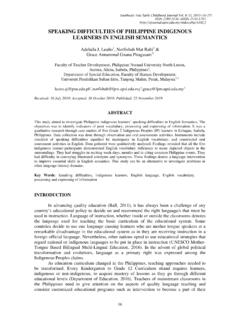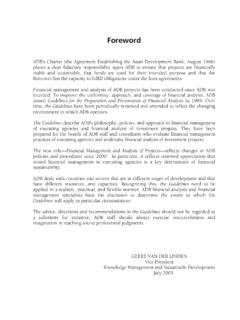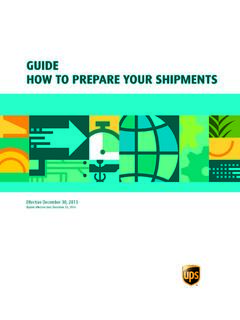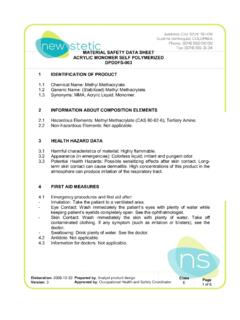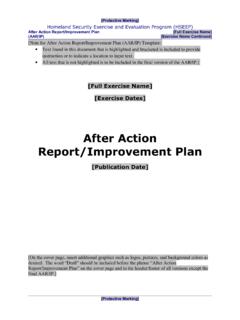Transcription of OECD DAC Rio Markers for Climate
1 OECD DAC Rio Markers for ClimateHandbook OECD DAC RIO Markers FOR Climate : HANDBOOK 1 OECD DAC Rio Markers for Climate : Handbook TABLE OF CONTENTS BACKGROUND .. 2 DEFINITION OF THE Climate CHANGE MITIGATION AND ADAPTATION Markers .. 3 SCORING SYSTEM FOR Climate Markers .. 5 USE OF Climate Markers FOR REPORTING TO THE UNITED NATIONS FRAMEWORK CONVENTION FOR Climate CHANGE (UNFCCC) .. 8 REPORTING FORMS AND EXAMPLES .. 9 INDICATIVE TABLE TO GUIDE RIO MARKING BY SECTOR/SUB-SECTOR .. 10 OECD DAC RIO Markers FOR Climate : HANDBOOK 2 BACKGROUND The OECD Development Assistance Committee (DAC) gathers on an annual basis statistics on official development assistance (ODA) and other resource flows to developing countries from bilateral and multilateral development co-operation providers. The data are publicly available in the Creditor Reporting System (CRS) database. Since 1998, the DAC has monitored development finance flows targeting the objectives of the Rio Conventions on biodiversity, Climate change and desertification through the CRS using the so-called Rio Markers .
2 The Rio Markers were originally designed to help members with the preparation of their National Communications or National Reports to the Rio Conventions, by identifying activities that mainstream the Conventions objectives into development co-operation. DAC members are requested to indicate for each development finance activity if the activity targets environmental objectives. The Rio Markers on biodiversity, Climate change mitigation and desertification were introduced in 1998, with a fourth marker on Climate change adaptation being applied to 2010 flows onwards. Rio Markers should be applied to all bilateral ODA and non-export credit other official flows (OOF)1, excluding general budget support, imputed student costs, debt relief except debt swaps, administrative costs, development awareness and refugees in donor countries. Multilateral contributions should not be marked by members individually; instead international organisations report on the actual allocation of their funds ( multilateral outflows ) and the Climate -related share of their portfolio is determined on that This document sets out the agreed definitions and reporting instructions for the providers of finance.
3 Further details on the methodology, background information, training materials and related resources are all available online. Additional information on the Rio Markers on Climate change mitigation and adaptation includes activity level project data, webinars on how to use and access the Climate Markers as well as a link to a visualization portal. 1 . Applying the Rio Markers to OOF is voluntary. The DAC statistical system is introducing the collection on amounts mobilised from the private sector by official interventions. Once in place (2017 reporting on 2016 data), the Rio Markers will also apply to the private amounts mobilised. 2 . To ensure consistency in reporting, members do not individually mark their multilateral contributions. Instead the international organisations apply the Rio Markers to their outflows, or in the case of Multilateral Development Banks (MDBs), report on components, elements or proportions of Climate finance based on the Joint MDB reporting approach.
4 This information is subsequently used to estimate members contributions to Climate through multilateral organisations ( imputed multilateral contributions ). OECD DAC RIO Markers FOR Climate : HANDBOOK 3 DEFINITION OF THE Climate CHANGE MITIGATION AND ADAPTATION Markers Climate change mitigation marker AID TARGETING THE OBJECTIVES OF THE FRAMEWORK CONVENTION ON Climate CHANGE Climate Change Mitigation DEFINITION An activity should be classified as Climate -change-mitigation related (score Principal or Significant) if: It contributes to the objective of stabilisation of greenhouse gas (GHG) concentrations in the atmosphere at a level that would prevent dangerous anthropogenic interference with the Climate system by promoting efforts to reduce or limit GHG emissions or to enhance GHG sequestration. CRITERIA FOR ELIGIBILITY The activity contributes to a) the mitigation of Climate change by limiting anthropogenic emissions of GHGs, including gases regulated by the Montreal Protocol; or b) the protection and/or enhancement of GHG sinks and reservoirs; or c) the integration of Climate change concerns with the recipient countries development objectives through institution building, capacity development, strengthening the regulatory and policy framework, or research; or d) developing countries efforts to meet their obligations under the Convention.
5 The activity will score principal objective if it directly and explicitly aims to achieve one or more of the above four criteria. See the indicative table for guidance on Rio marking by sector/subsector and examples of qualifying activities. OECD DAC RIO Markers FOR Climate : HANDBOOK 4 Climate change adaptation marker AID TARGETING THE OBJECTIVES OF THE FRAMEWORK CONVENTION ON Climate CHANGE Climate Change Adaptation DEFINITION An activity should be classified as adaptation-related (score Principal or Significant) if: It intends to reduce the vulnerability of human or natural systems to the current and expected impacts of Climate change, including Climate variability, by maintaining or increasing resilience, through increased ability to adapt to, or absorb, Climate change stresses, shocks and variability and/or by helping reduce exposure to them. This encompasses a range of activities from information and knowledge generation, to capacity development, planning and the implementation of Climate change adaptation actions.
6 CRITERIA FOR ELIGIBILITY An activity is eligible for the Climate change adaptation marker if: a) the Climate change adaptation objective is explicitly indicated in the activity documentation; and b) the activity contains specific measures targeting the definition above. Carrying out an assessment of vulnerability to Climate variability and change, either separately or as an integral part of agencies standard procedures, facilitates this approach. To guide scoring, a three-step approach is recommended as a best practice , in particular to justify for a principal score: Setting out the context of risks, vulnerabilities and impacts related to Climate variability and Climate change: for a project to be considered as one that contributes to adaptation to Climate change, the context of Climate vulnerability should be set out clearly using a robust evidence base. This could take a variety of forms, including use of material from existing analyses and reports, or original, bespoke Climate vulnerability assessment analysis carried out as part of the preparation of a project.
7 Stating the intent to address the identified risks, vulnerabilities and impacts in project documentation: The project should set out how it intends to address the context- and location- specific Climate change vulnerabilities, as set out in existing analyses, reports or the project s Climate vulnerability assessment. Demonstrating a clear and direct link between the identified risks, vulnerabilities and impacts and the specific project activities: the project should explicitly address risk and vulnerabilities under current and future Climate change as identified in the project documentation. See the indicative table for guidance on Rio marking by sector/subsector and examples of qualifying activities. OECD DAC RIO Markers FOR Climate : HANDBOOK 5 SCORING SYSTEM FOR Climate Markers A scoring system of three values is used, in which official development finance activities reported to the DAC CRS are screened and marked as either (i) targeting the United Nations Framework Convention on Climate Change (UNFCCC) as a principal objective (score 2 ); (ii) as a significant objective (score 1 ); or (iii) not targeting the Convention (score 0 ).
8 These marks indicate the policy objectives of members development finance activities: An activity can be marked as principal when the objective ( Climate change mitigation or adaptation) is explicitly stated as fundamental in the design of, or the motivation for, the activity. Promoting the objective will thus be stated in the activity documentation as one of the principal reasons for undertaking it. In other words, the activity would not have been funded (or designed that way) but for that objective. An activity can be marked as significant when the objective ( Climate change mitigation or adaptation) is explicitly stated but it is not the fundamental driver or motivation for undertaking it. Instead, the activity has other prime objectives but it has been formulated or adjusted to help meet the relevant Climate concerns. The score 0 means that the activity was examined but found not to target the objective ( Climate change mitigation or adaptation) in any significant way.
9 For activities that have not been assessed, the marker field should be left empty. This ensures that there is no confusion between activities that do not target the objective (score = 0 ), and activities for which the answer is not known (score = null ). This important distinction has implications for statistical presentations of Rio marker data. The emphasis of the Markers is on the objective pursued in providing support for the activity in question, as described in the activity documentation primarily the written material which forms the basis for the agreement to provide funding. This may be the actual project or programme document, or a proposal for funding an action which is outlined in a partner country document such as a national development strategy, a sectoral strategy or Climate change strategy. To facilitate transparency, it is important that in the description of activities reported to the CRS, the relationship between the activity and the objective ( Climate change mitigation/adaptation) is clearly communicated and made explicit.
10 This is particularly important for activities with a principal objective score and for very large activities (recognising the administrative constraint this implies when numerous small activities are concerned). The following decision tree helps identify for which score a given activity qualifies. OECD DAC RIO Markers FOR Climate : HANDBOOK 6 Decision tree for scoring an activity against a Rio marker *Assigning a double principal score ( to both mitigation and adaptation) to the same activity should be considered only upon explicit justification. Qualitative methodology allowing an approximate quantification of finance flows By identifying activities targeting Climate change as a principal or significant objective, the Markers provide an indication of the degree of mainstreaming of environmental considerations into development co-operation portfolios. The Rio Markers apply to activities as a whole, and, in marking the full value of the activities the Markers are considered descriptive rather than strictly quantitative.










